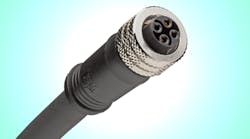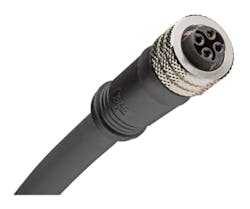Enhancing Ethernet for Industrial Applications
Download this article in .PDF format
Ethernet is the go-to networking technology for practically all networking needs. It forms the backbone of most enterprise, campus, and small- and medium-sized company local area networks (LANs). It’s also at the heart of most data centers and many metropolitan area networks (MANs). What IT system doesn’t use Ethernet today?
These days, Ethernet can be found in factory automation as well as industrial monitoring and control systems—but not without some modifications. Here’s a look at how enhancements to Ethernet help it meet stringent industrial requirements.
The Benefits of Ethernet
There are plenty of reasons why Ethernet has become the networking technology of choice. For one, widespread use of Ethernet in the commercial and enterprise markets has made equipment readily available. High-volume use of cabling, switches, hubs, network interface cards, repeaters and routers makes prices affordable. Formal IEEE standards (802.3) ensure consistent performance and full interoperability. Also, thanks to the multiple versions of Ethernet, a data rate and feature set exists for almost every application. On top of that, broad usage of Ethernet means that a large base of personnel can provide the technical expertise for installing, operating, and troubleshooting an Ethernet network.
All of these benefits make Ethernet an excellent choice for new or replacement industrial networks. However, Ethernet was not designed with industrial applications in mind, which caused some hiccups in such settings. The good news is that these disadvantages can be overcome with some relatively simple hardware and software enhancements.
Disadvantages in an Industrial Setting
Industrial networks are used to connect devices in a factory or process-control facility. Such devices range from sensors and programmable logic controllers (PLCs) to computer numerically controlled (CNC) machine tools like drills, routers and lathes, and robots. There are three primary challenges to using commercial Ethernet for such communications.
The first challenge concerns the vulnerability of Ethernet equipment to harsh environments typical in plants and factories or the outdoors. Most Ethernet cabling and equipment cannot handle the temperature, humidity, vibration, mechanical stress, noise, dirt, harsh chemicals, high electrical voltages, or other environmental hazards.
Second, there’s the major issue of excessive latency in many industrial applications. Latency is essentially the time it takes for a data packet to transit the network from transmitter to receiver. Ethernet’s CSMA/CD (carrier sense multiple access with collision detection) access method often is the cause of such a delay in packet transmission.
With this access mode, many users or devices are able to share the network, but only one can transmit at a time. If user number one attempts to send data while user number two is transmitting, then user one must back off and wait. Thus, Ethernet is not inherently synchronous or repeatable. Even though the delay may only be a few hundred milliseconds, it is an unacceptable latency for many industrial applications. Such latency is typically invisible to commercial users who routinely don’t notice the latency in everyday uses (e.g., email, Internet searches). However, factory automation devices need real-time or near-real-time responses to work properly.
Another related issue is determinism. Determinism is the ability to predict a packet’s arrival time. Some industrial equipment must receive packets at a specific time. Therefore, it’s necessary for the network and equipment to be able to schedule and deliver precise data-transmission and reception times.
1. These M8 and M12 micro connectors can be used in place of standard RJ45 connectors for industrial Ethernet networks (Courtesy of Molex).
Almost all industrial equipment depends on fast response times. The general rule-of-thumb is latency cannot exceed 10 ms at most. Many applications require latency to be no more than several milliseconds, while others won’t tolerate latency beyond several hundred microseconds. Such times typically can’t be achieved with standard Ethernet gear.
The third challenge regarding Ethernet is susceptibility to electromagnetic interference (EMI). Industrial Ethernet equipment must have electromagnetic compatibility (EMC) that’s able to operate reliably in a high-EMI environment, such as a factory. Industrial facilities typically generate lots of EMI. Electrical noise comes from the high-voltage lines, motors, switches, machine tool controllers, and a variety of special electronic devices. This noise is radiated and subsequently picked up by network cabling, equipment, and computers, causing data errors or missing transmissions.
A related enemy is electrostatic discharge (ESD). ESD is high voltage static charges that can build up on some equipment or in some processes. This ESD can disrupt or damage other devices, and must be dealt with.
These problems plaguing standard Ethernet do have solutions, though, making Ethernet suitable for most industrial applications.
Augmenting Ethernet
The environmental deficiencies of standard Ethernet can be overcome in a variety of ways. For example, one can acquire special hardened Ethernet switches, hubs, and other gear that are designed to withstand rugged industrial environments. Otherwise, standard Ethernet equipment can be housed in special protective industrial cabinets built for use in factories and plants.
The most critical part of the industrial network is its wiring. Most commercial office Ethernet systems use CAT5, CAT5e, or CAT6 unshielded-twisted-pair (UTP) cables. Such cables can’t stand up to the majority of harsh industrial settings. It’s essential to use special cable jackets that are more tolerant of higher temperature and humidity conditions, resistant to oil or other liquids, flame retardant and resistant to fire, and more flexible to motion.
One special note: It’s important not to exceed guidelines for Ethernet cable lengths. Typically, the maximum length of any connections must not exceed 100 meters. One useful rule is to limit any horizontal run to 90 meters and allow for 10 meters of patch cable. Surpassing the maximum length specification results in signal attenuation and distortion, which usually cause packet loss in a critical industrial process. If cable length is an issue, use a repeater or extra switch to extend the network.
Don’t overlook the importance of improved connectors. Standard RJ45 connectors aren’t designed for industrial environments, and have proven to fail because of dirt, corrosion, and excessive stress. To avoid that problem, special enclosed RJ45 connectors have been developed for rugged environments. Or opt for the newer M8 and M12 connectors designed for factory use (Fig. 1).
Another cabling solution is to go the fiber-optic route. Industrial-grade fiber-optic cable is available, and the Ethernet standard 802.3z supports a 1-Gb/s data rate. Though more expensive, fiber cables are immune to noise and crosstalk pickup so common on UTP cables.
Solving Latency
One way to overcome latency and non-determinism problems is to use faster versions of Ethernet, such as Gigabit Ethernet standard IEEE 802.3ab. This is usually fast enough for most industrial applications if latency is manageable. Of course, 10 Gigabit Ethernet is available, but it requires special CAT6A or CAT7 cabling and more expensive switches. Its primary use is for high-resolution video or data-center connections. A better solution is to use multiple Ethernet switches to partition the network into logical segments. This limits the number of user nodes per segment, reducing the amount of potential collisions and reducing latency.
2. Here, the standard Ethernet packet or frame shows the start of frame delimiter (SFD) and its position with relation to the other fields.
Low latency and determinism can also be achieved by using one of several special protocols designed to enhance Ethernet. These protocols, which are encapsulated in the standard Ethernet packet, provide software services that correct Ethernet’s limitations. Such protocols include prioritization and synchronization along with other methods that provide faster and more predictable packet delivery, namely EtherCAT, POWERLINK, Profinet, Modbus-TCP, and EtherNet/IP. The protocols use TCP/IP or UDP in addition to other protocols to deliver near-real-time response levels. Some require special hardware. In all cases, though, they readily achieve response times of less than one millisecond and lower.
Another way to ensure low latency is to select equipment that uses Ethernet transceiver ICs. The chips mitigate latency with internal circuitry and/or software; newer versions offer built-in solutions and some feature EMI/EMC compliance.
One more approach is to use the IEEE 1588 Precision Time Protocol (PTP). This enhancement provides clock synchronization and timing control at the sub-microsecond level. PTP is used to time-stamp packets for synchronizing devices across a network. PTP utilizes the Ethernet packet-frame start of frame delimiter (SFD) field as a reference point in time-stamping (Fig. 2). The SFD of hex 0x5D occurs after the frame preamble of hex 0x55 to generate a pulse that’s used to determine the latency in a link.
With regard to EMI/EMC compliance, one can look into multiple possible solutions. EMI abatement begins by applying the basic EMI solutions of grounding, shielding, and filtering. For instance, Ethernet equipment can be housed in shielded cabinets. One of the most effective protections other than using fiber is to use shielded UTP cable. Grounding guidelines vary—some cable manufacturers recommend grounding only one end of the cable shield to prevent ground loops, while others say ground both ends of the shield. Experimentation is usually necessary to find the best solution.
Finally, the ESD problem can be solved by using equipment specially designed for ESD suppression. When designing industrial Ethernet equipment, opt for chips with internal ESD protection. Special solid-state ESD suppression devices are also available to add protection where needed.



